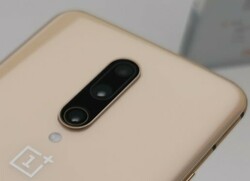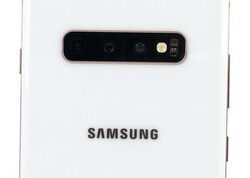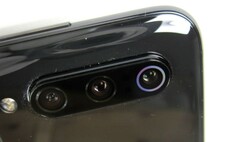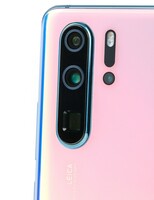When looking at the various reviews of the most-hyped smartphone of mid 2019, the OnePlus 7 Pro one might get the impression that not all OnePlus 7 Pros are alike. Some reviewers claim that camera quality is in dire need of improvement while others, ourselves included, come to the conclusion that the OnePlus 7 Pro’s camera is decent, albeit not exceptional or outstanding in any way.
However, the latest OTA updates - see here - are supposed to have improved upon the camera and photo quality significantly. Shortly before we embarked on this comparison, the Chinese manufacturer released OxygenOS 9.5.7 containing yet more camera refinements, including among others an improved night mode.
We took a closer look at the OnePlus 7 Pro’s camera in various scenarios and under different circumstances and lighting conditions in order to find out whether this latest firmware improved the photo quality enough for it to challenge the current top dogs in smartphone photography. But first, let us review the technical specifications of the various cameras contained in this comparison.
Cameras in Comparison
The OnePlus 7 Pro's main camera features a 48 MP Sony sensor with a wide-open aperture of f/1.6. The Quad Bayer filter combines 2 x 2 adjacent pixels into one large pixel, thereby reducing the effective camera resolution to 12 MP. This so-called 4-in-1 pixel binning is supposed to drastically improve low-light photography. In addition to this lens the main Pro’s triple-cam also includes a wide-angle lens and a telephoto lens for a lossless 3x zoom. At least on paper, that is, because in reality the “optical” zoom is much closer to 2.2x instead of 3x.
At the rear of Xiaomi Mi 9 we find the same 48 MP sensor combined with a slightly less light-sensitive aperture of f/1.75. In addition, the device also features an ultra-wide-angle lens as well as a telephoto lens for lossless 2x optical zoom and adjustable background blur.
The Huawei P30 Pro's Leica camera module is a combination of four lenses in total, although the TOF camera (time of flight) does not take photos but rather measures the return trip time for each pixel, thereby creating a 3D profile of the scene. An ultra-wide-angle lens and a telephoto lens are included. The main camera features a 40 MP RYYB super spectrum sensor with an aperture of f/1.6. Like Sony’s IMX586 sensor it combines four individual adjacent pixels into a single large pixel.
Like last year, this year’s Galaxy S10 Plus features a 12 MP lens with large native pixels, a dual-pixel autofocus, and a variable aperture of between f/1.5 and f/2.4. As is quite customary these days the Korean manufacturer has also added a super-wide-angle and a telephoto lens to its main rear-facing camera module.
| OnePlus 7 Pro | Samsung Galaxy S10+ | Xiaomi Mi 9 | Huawei P30 Pro | |
|---|---|---|---|---|
| rear-facing camera | 48 MPix Sony IMX586, 1,6 μm, f/1.6, OIS (camera 1), 8 MP Tele, 1 μm, OIS, f/2.4 (camera 2), 16 MP ultra-wide-angle, f/2.2 (camera 3), triple-autofocus: PDAF, laser, contrast | 12 MPix (dual-pixel-autofocus, 77°, f/1.5/f2.4, 1.4 µm, OIS) + 12 MPix (telephoto lens, 2x zoom, PDAF, 45°, f/2.4, OIS) + 16 MPix (ultra-wide-angle, fix-focus, 123°, f/2.2) | 48 MPix triple-camera: 48 MP main camera (Sony IMX586, f/1.75, 1/2", 0,8 µm) + 16 MP wide-angle camera (f/2.2, 13 mm, 1/3.0", 1,0 µm) + 12 MP zoom camera (f/2.2, 54 mm, 1/3.6", 1.0 µm, 2x optical zoom) | 40 MPix main camera (f/1.6, OIS, 27 mm) + 20 MPix ultra-wide-angle camera (f/2.2, 16 mm) + 8 MPix telephoto camera (f/3.4, OIS, 125 mm) + TOF camera, 10x hybrid zoom, 50x digital zoom |
| Front-facing camera | 16 MPix Sony IMX471, 1 μm, f/2.0, fix-focus, EIS, pop-up | 10 MPix (dual-pixel autofocus, 80°, f/1.9) + 8 MPix (RGB depth, fix-focus, 90°, f/2.2) | 20 MPix f/2.0, 0.9 µm, HDR, fix-focus | 32 MPix, f/1.7, HDR, fix-focus |
| software version | 9.5.7 | G957FXXU1ASE7 | 10.2.26 | 9.1.0.153 |
Rear-Facing Cameras
All smartphones included in this comparison offer a variety of different camera modes. In this test, we decided to limit ourselves to photo mode, portrait mode, and night mode, which are featured on every device albeit under different names. In order to ensure comparability we disabled all AI features, if available, and left the camera settings at their ex-factory default configuration. In other words, the resulting photo resolutions where as follows: OnePlus 7 Pro: 12 MP; Xiaomi Mi 9: 12 MP; Samsung Galaxy S10 Plus: 12 MP; Huawei P30 Pro: 10 MP. All devices were up-to-date and had the latest available firmware installed. For zoomed-in photos we opted for a 2x optical zoom on all cameras.
In order to be able to better differentiate the photo details between the respective devices we have included all photo files with their respective photos.
Daylight
Bright daylight resulted in the most noticeable differences in terms of color management and focus between the respective devices in our comparison group. The bokeh effects in portrait mode worked very well on all devices, and the transitions between blurry objects and those in focus was spot-on. The horse’s color was oversaturated in the OnePlus 7 Pro's portrait mode. In return, it offered the best focus of all devices around the grassy area. The Samsung Galaxy S10 Plus had the highest color accuracy, but could have benefited from better focus. The Xiaomi Mi 9 was somewhat pale and not completely in focus, and the Huawei P30 Pro turned out too dark, too pale, and too dull.
In our close-up scenario the Galaxy S10 Plus offered the highest level of detail and focus with very accurate colors to boot. The latter were natural yet slightly oversaturated on the OnePlus 7 Pro and the Xiaomi Mi 9, however, these two were slightly out of focus around the flower. Huawei’s P30 Pro did a better job in this regard, however, it captured the scene with a noticeable yellow tint and a color temperature that was too warm.
The third and fourth daylight scene were long-distance shots. The OnePlus 7 Pro featured a high contrast range and natural colors - even letters that were far away were captured surprisingly clearly. In return, its dynamic range was subpar. An area where the Galaxy S10 Plus and P30 Pro excelled, although we should add that the clouds made for different lighting conditions between the photos. An excuse that cannot explain the Xiaomi Mi 9’s results - its focus was significantly worse than on the other three devices, and like on the P30 Pro it featured a warmer white balance and a lower contrast ratio.
When using the lossless zoom feature the differences between the smartphones were immense. The Xiaomi Mi 9's color temperature was a bit too cool, and focus deteriorated noticeably when compared to the main lens. The same can be said about the P30 Pro, whose white balance was once again shifted towards the yellow side of the spectrum. In our opinion, the OnePlus 7 Pro took the best photo in this particular test. The scene was in focus and crisp, colors were natural, and the photo was rich in detail. Compare that to the Galaxy S10 Plus with its slightly higher saturation and narrower range of contrast.
When using the wide-angle lens all smartphones showed a noticeable decrease in details and dynamic range. The Mi 9’s photo showed a slight yellow tint once more, although its color accuracy was more natural than on all of its competitors. The contrast ratio and dynamic range of the OnePlus 7 Pro were on a par with the Galaxy S10 Plus and P30 Pro, although the letters on the left side were visibly blurry. All things considered photos taken with the Huawei P30 Pro featured the highest range of contrast, but were slightly over-sharpened in return. The unavoidable optical distortions were tolerable overall.
Nighttime and Twilight
Twilight is when the Huawei P30 Pro starts to shine. In low light all devices suffered from visibly more noise and less focus. The P30’s SuperSpectrum sensor’s performance was impressive, and the level of noise in its photos was lower than on all other competitors. The two IMX586-based devices - Pro and Mi - suffered quite noticeably from reduced focus and details, although the OnePlus 7 Pro outperformed the Xiaomi Mi 9 slightly in terms of focus. The Galaxy S10 Plus produced clear and well-illuminated photos, rich in contrast. However, its photos did not contain more details than its competitors’ and were drastically over-sharpened to boot.
When using the night mode, which takes several images that are then combined into a single best-case photo, the Huawei P30 Pro once more outclassed its competitors. However, this time the OnePlus 7 Pro performed much better when compared to the Galaxy S10 Plus in terms of illumination and brightness thanks to which it was capable of capturing more details and suffered less from camera shake. With the lowest level of detail and focus the Mi 9 produced the worst night mode results.
The other two lenses on each device - wide angle and zoom - produced very different results. Despite the fact that all devices had the same aperture of f/2.2, in this scenario the Galaxy S10 Plus and Huawei P30 Pro were able to capture more light than their competitors and thus richer in detail in return. The OnePlus 7 Pro and Xiaomi Mi 9 showed less focus and a visible and pronounced soft-focus overlay over the entire photo. In addition, wide-angle photos turned out very dark and low in dynamic range.
Using the optical 2x zoom details were hard to differentiate from one another on all devices. The OnePlus 7 Pro and Huawei P30 Pro were slightly better in terms of focus than the Samsung Galaxy S10 and Xiaomi Mi 9. The latter in particular was once again incapable of keeping up with its competitors.
Front-Facing Camera
Except for the S10 with its dual-camera with dual-pixel autofocus, all devices featured comparable front-facing cameras. In addition to depth-of-field information the Samsung Galaxy S10 Plus’s secondary lens can also be used for wide-angle selfies, although this feature was not part of this test.
Accordingly, it was not particularly surprising that the Galaxy S10 captured more light than its competitors and produced very good-looking selfies. That said the differences in terms of focus, dynamic range, and color accuracy between the Samsung and the OnePlus 7 Pro were almost negligible. Something that cannot be said about the Xiaomi Mi 9 and P30 Pro, as both were incapable of producing shots with a similar level of color accuracy and even more so, focus.
Low light resulted in very noisy results very quickly on all contenders, and the soft-focus effect was dramatic. The Galaxy S10 Plus and Xiaomi Mi 9 suffered the most, and the P30’s result completely lacked fine details in the beard. The OnePlus 7 Pro’s pop-up camera was the best selfie camera in this test.
Verdict

When lighting conditions are good all devices in our comparison group produced decent and good-looking photos with only minor differences in terms of dynamic range, focus, and color management. Our favorite phone differed from scene to scene - sometimes the Samsung Galaxy S10 Plus produced the best results, sometimes it was the OnePlus 7 Pro that outshone its rivals. That said the differences compared to the other two contenders, the Xiaomi Mi 9 and the Huawei P30 Pro, were not very pronounced.
The OnePlus 7 Pro’s Sony IMX586 sensor is very light-sensitive thanks to its 4-in-1 pixel binning technology. However, that is only half the battle. The other half depends on camera software and the algorithms that are trying to get the most out of these complex CMOS sensors. As our Xiaomi Mi series camera test has shown, combining four adjacent pixels into a single large pixel is a highly complicated procedure, particularly in low-light conditions. Accordingly, camera sensors with large native pixels of more than 1.4 µm tend to do better in these scenarios. This impression was further corroborated by today’s comparison and the differences between the two Sony IMX586-based smartphones (OnePlus 7 Pro and Xiaomi Mi 9) on the one hand and the Galaxy S10 Plus on the other. All things considered, the OnePlus 7 Pro’s camera software and its post-processing algorithms outperformed Xiaomi’s counterparts. However, Huawei’s Leica-optimized SuperSpectrum sensor was able to outperform all three of its competitors in poor lighting conditions, and the Chinese manufacturer’s algorithms benefitted the most from pixel binning technology. In low light the P30 Pro’s photos were comparatively rich in detail and low in noise. Samsung’s S10 Plus was somewhere in-between the P30 Pro and the OnePlus 7 Pro, although it was much closer to the latter than the former.
The results were completely different when looking at the front-facing cameras, and Huawei’s smartphone was not able to keep up with its own rear-facing camera’s performance in terms of brightness/illumination, dynamic range, and details. In this test, the OnePlus 7 Pro outperformed its competitors and produced the best-looking selfies. Even in bright daylight the only device capable of keeping up with it was Samsung’s Galaxy S10 Plus.
It is nearly impossible to crown a victor in this comparison. However, the best all-rounder is most certainly Samsung’s Galaxy S10 Plus.


























































































